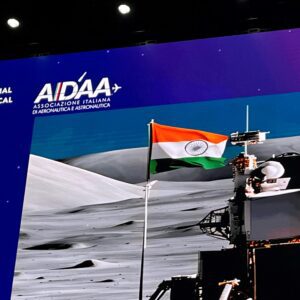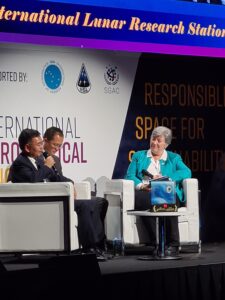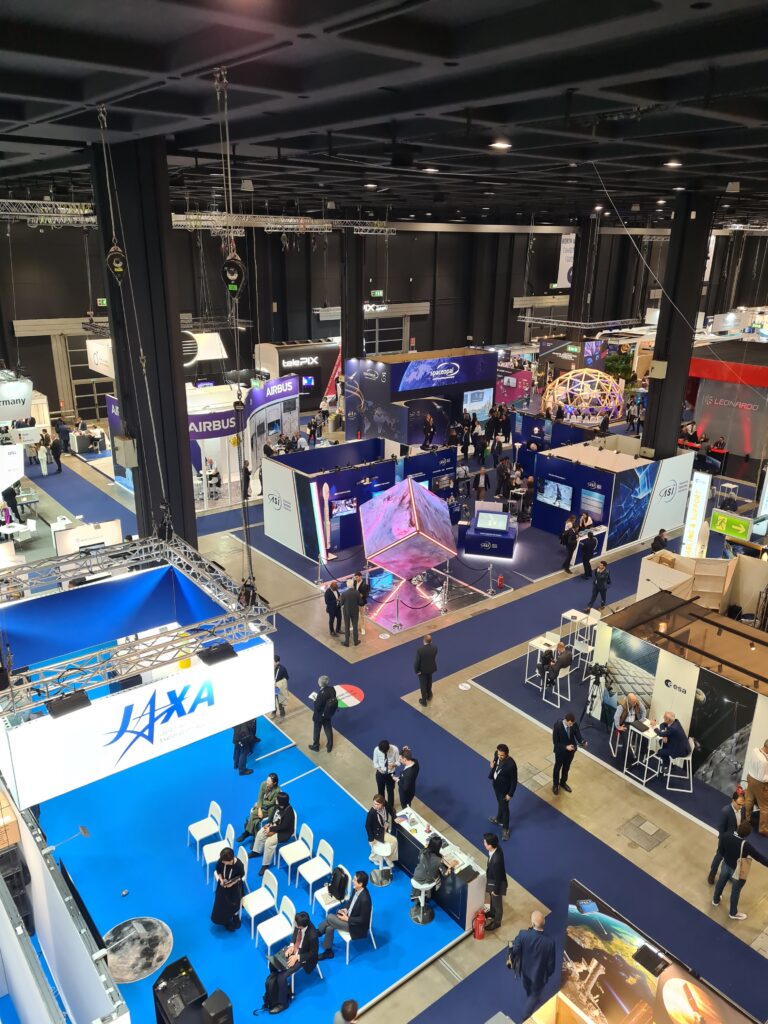The annual International Astronautical Congress (IAC) is the primary meeting place for space agencies to get together. That and the fact that it was hosted in highly fashionable Milan, in Northern Italy, made IAC the place to be seen this October. This fact was clearly taken heed of as a record 11,000 people showed up at the conference. In keeping with the enormous audience, thousands of abstracts were submitted by those hoping to get their research published and presented as technical papers. Next year IAC will be in Sydney, Australia.

Gelato trolleys were a daily and welcome treat at the IAC 2024 conference in Milan. Courtesy: Farah Ghouri
The conference had it all: there was gelato, oven-fired pizzas, a convoluted conference layout (that had delegates commiserating with each other on being lost), a fashion moment with Prada, the surprise appearance of Italy’s President mid-way through the opening ceremony and, of course, a healthy dose of queues.

A record 11,000 people registered to attend the International Astronautical Congress (IAC) in Milan in October. Courtesy: Farah Ghouri
The main event of the first day, as always, was the Heads of Space Plenary with a slightly different format to previous years. Rather than sitting together – a visual encapsulation of international cooperation – the agency heads were individually interviewed and took turns to sit on the stage. Perhaps due to geopolitical international tensions, even surprising ones such as that between Canada and India, it seemed that they did not want to be seen together on the same stage. The optics sent a rather different message than that of peace on Earth and in space.
India took centre stage amid world space agency heads
ISRO’s Dr Somanath, Chairman of the Indian Space Research Organisation (ISRO), had a lot to crow about given the success of the Chandrayaan-3 mission. In the opening ceremony he received the International Astronautical Federation (IAF) World Space award for the landing mission at the Lunar South pole. This was well deserved as India is becoming a major space power (arguably it already is).

India’s lunar ambitions were on display at the IAC. Courtesy: Farah Ghouri
Somanath looked ahead to new endeavours – specifically, to the task of developing India’s reusable rocket capability. “Reusability is Mandatory,” he said. ISRO plans to spend US$1 billion on a Next Generation Launch Vehicle (NGLV), which it hopes will be available by 2033. To achieve this new heavy-lift rocket, he said ISRO was working on a throttleable rocket engine powered by LOX (Liquid Oxygen) and liquid methane.
India’s lunar aspirations include conducting its first human spaceflight missions (after three test flights) by the end of 2026 and building its own space station. The Bhartiya Antariksha Station (BAS) will consist of five modules and weigh 52 metric tons. Additionally, the agency plans to develop a lunar relay constellation of six spacecraft.
Japan
The Japanese space agency (JAXA) plans to fly a 50 kg rover to the Moon aboard India’s Chandrayaan 4 Lupex lunar sample return mission to a permanently shadowed area at the Lunar South Pole. This would be followed by Chandrayaan 5 to demonstrate long-term survivability.
While reusability may be the future (the SpaceX ‘chopsticks’ grab of its reusable Super Heavy stage on the Starship IFT-5 flight dominated global headlines), expendable rockets will remain competitive for a while yet, if done correctly. The Head of JAXA, Hiroshi Yamakawa, hailed the successful second and third flights of Japan’s H-3 rocket which, unlike some other new expendable entrants, really will be competitive against part-reusable types such as the Falcon 9.
Confidence in Japan’s H-3 is quietly growing. The improvements planned for H3 include a multi-satellite adaptor and a new upper stage with an upgraded LE-5B-3 engine. Shoyo Hyodo, Manager at Mitsubishi Heavy Industries, highlighted that a new heavy-lift version of H-3, with a core plus boosters configuration (similar to the Falcon Heavy) is in development. The hope is that this will carry humans to LEO by 2030 and up to six metric tons to the lunar surface.
China shows off its prowess – Mars is in its sights

Guoping Li, Chief Engineer at China National Space Administration, exhibited a box containing lunar samples from the Moon. Courtesy: Farah Ghouri
China used IAC to show off a little. And who can blame them? The Chinese National Space Agency (CNSA) plans to land a human on the Moon by 2030 and beat the US back to the Moon in doing so. It also wants to conduct a Mars sample return mission in 2028 that could beat NASA’s cash-strapped plan. Feng Guan, Director of Lunar Exploration at CNSA, and Guaping Li, Chief Engineer, described the recent successes of the Chang’e mission with pride. They also went to some pains to emphasise China’s international outlook, pointing to its offer of scientific payload rides on the Chang’e missions.
Last show for NASA Administrator Bill Nelson?

NASA administrator Bill Nelson took questions from Slingshot/Seradata Space Intelligence (SSI) reporters during one of the press conferences at IAC. Courtesy: Farah Ghouri
A surprisingly under-attended event was a press conference with NASA Administrator Bill Nelson, with a distinct lack of reporters. We asked former Senator Nelson whether, like his namesake, he was ‘turning a blind eye’ to the expected lateness of the Human Landing System (HLS), built by SpaceX, required for the Artemis missions. Nelson said he had every confidence that HLS was on schedule for a crewed Artemis landing on the Moon (Artemis 3) in September 2026.
The need for a working HLS (one wonders why NASA did not go for a simpler storable propellant lander for the early Artemis landings) was underlined by the big story of the show: the announcement of the readiness of the Axiom lunar space suit.
We pressed Nelson on the finer points of the Artemis Accords, a topic frequently brought up at the conference, and to clarify who would be the ultimate arbiter of the non-binding agreement that 47 countries have so far signed. Nelson said that “the Artemis Accords are very clear” but declined to directly answer the question.
With the US Presidential election looming, we asked Nelson if he wanted to continue to lead NASA following the results. His Delphic answer was simply: “I serve at the pleasure of the President.” We suspect not for much longer.
ULA CEO asks audience to take a closer look at price comparisons
ULA CEO Tory Bruno used his keynote in a technical presentation to admonish those who opine that SpaceX’s partially reusable rockets were always more cost-effective. He pointed out that, for certain high-energy orbits, his single core Vulcan Centaur design was “cheaper than the other guy,” referring to the three-booster Falcon Heavy.

Tory Bruno, CEO of ULA, gave a keynote at the conference. Courtesy: David Todd
Yet even Bruno’s outfit is bringing in reusability, as revealed when he outlined incremental improvements planned for ULA’s rocket. These include working on a way of reusing the engine pod of the Vulcan first stage by employing inflatable heatshields and parachute splashdowns. The heatshield is derived from the NASA HIAD – Hypersonic Inflatable Aerodynamic Decelerator system. ULA plans to use additive manufacturing (3D printing) to produce newer cheaper versions of the RL-10 engine for the Centaur V’s upper stage.
Bruno batted off any notion that the last Vulcan flight was in any way a failure. This was the second certification launch for the US government carrying an instrumented payload, which it managed to place into its correct orbit despite a GEM-60XL booster nozzle failure. He also paid tribute to the BE-4 core stage engines (powered by LOX/methane) built by Blue Origin that overcame combustion instability issues.
Meanwhile, in Europe…
A new upper stage, using LOX/methane as propellants, is in the works for Vega, a launch vehicle that is struggling to maintain its competitiveness. Enrico Calvallini, Head of Space Transportation at the European Space Agency (ESA), did his best to convince his audience otherwise during a technical session. Yet even he conceded that European rockets such as Vega cost more to build compared with those from the likes of SpaceX that build everything in-house.
While doubts over the competitiveness of Ariane 6 persist in the international marketplace, the rocket will soon have improved solid rocket boosters (SRBs) on a new Block 2 version, while Block 3 will be upgraded with a new upper stage, according to Aline Decadi, an engineer at ESA. Looking forward, Dr Martin Sippel, the lead of Space Transport Systems at DLR, examined the options for converting Ariane 6 into a reusable rocket or beginning a new European one.
Who was missing from IAC 2024?
Most obviously absent from IAC’s exhibition hall was SpaceX, but thanks to the successful capture (likened to using ‘chopsticks’) of its reusable Super Heavy stage on the Starship IFT-5 flight, the company was frequently mentioned throughout the conference.
While 60 space agency heads attended the first space head summit at IAC, Roscosmos was not one of them due to the war in Ukraine and the related travel sanctions on its leadership.
Finally, but certainly not least, there were far too few press conferences and journalists, as far as we could see. This might be due to a clampdown on delegates who masquerade as ‘press’ but produce only a single article just to get free entry. Nevertheless, there should have been more accredited journalists accepted to cover the congress.

Courtesy: Farah Ghouri





